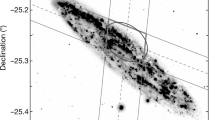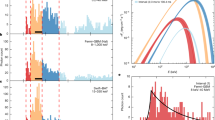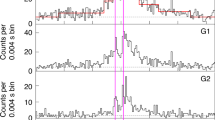Abstract
Two classes of rotating neutron stars—soft γ-ray repeaters (SGRs) and anomalous X-ray pulsars—are magnetars1, whose X-ray emission is powered by a very strong magnetic field (B ≈ 1015 G). SGRs occasionally become ‘active’, producing many short X-ray bursts. Extremely rarely, an SGR emits a giant flare with a total energy about a thousand times higher than in a typical burst2,3,4. Here we report that SGR 1806–20 emitted a giant flare on 27 December 2004. The total (isotropic) flare energy is 2 × 1046 erg, which is about a hundred times higher than the other two previously observed giant flares. The energy release probably occurred during a catastrophic reconfiguration of the neutron star's magnetic field. If the event had occurred at a larger distance, but within 40 megaparsecs, it would have resembled a short, hard γ-ray burst, suggesting that flares from extragalactic SGRs may form a subclass of such bursts.
This is a preview of subscription content, access via your institution
Access options
Subscribe to this journal
Receive 51 print issues and online access
$199.00 per year
only $3.90 per issue
Buy this article
- Purchase on Springer Link
- Instant access to full article PDF
Prices may be subject to local taxes which are calculated during checkout


Similar content being viewed by others
References
Thompson, C. & Duncan, R. C. The soft gamma repeaters as very strongly magnetized neutron stars. I. Radiative mechanism for outbursts. Mon. Not. R. Astron. Soc. 275, 255–300 (1995)
Mazets, E. P., Golenetskii, S. V., Ilinskii, V. N., Apetkar, R. L. & Guryan, Y. A. Observations of a flaring X-ray pulsar in Dorado. Nature 282, 587–589 (1979)
Fenimore, E. E., Klebesadel, R. W. & Laros, J. G. The 1979 March 5 gamma-ray transient: was it a classic gamma-ray burst? Astrophys. J. 460, 964–975 (1996)
Hurley, K. et al. A giant periodic flare from the soft gamma-ray repeater SGR 1900 + 14. Nature 397, 41–43 (1999)
Hurley, K. et al. Reactivation and precise interplanetary network localization of the soft gamma repeater SGR 1900 + 14. Astrophys. J. 510, L107–L109 (1999)
Woods, P. M. et al. Gradual brightening of SGR 1806 - 20. Astron. Telegr. 313 (2004)
Gehrels, N. et al. The SWIFT gamma-ray burst mission. Astrophys. J. 611, 1005–1020 (2004)
Borkowski, D. et al. Giant flare from SGR 1806 - 20 detected by INTEGRAL. GCN Circ. 2920 (2004)
Palmer, D. M. et al. SGR1806 - 20: Swift-BAT observation of the 041227 super-flare. GCN Circ. 2925 (2004)
Hurley, K. et al. An exceptionally bright flare from SGR1806 - 20 and the origins of short-duration γ-ray bursts. Nature doi:10.1038/nature03519 (this issue)
Barthelmy, S. D. Burst Alert Telescope (BAT) on the Swift MIDEX mission. SPIE 5165, 175–189 (2004)
Belian, R. D., Gisler, G. R., Cayton, T. & Christensen, R. High-Z energetic particles at geosynchronous orbit during the great solar proton event series of October 1989. J. Geophys. Res. 97(A11), 16897–16906 (1992)
Meier, M. M. et al. in the Proc. Workshop on the Earth's Trapped Particle Environment, AIP Conf. Proc. 383, 203–210 AIP Press, Woodbury, New York (1996).
Kouveliotou, C. et al. Identification of two classes of gamma-ray bursts. Astrophys. J. 413, L101–L104 (1993)
Corbel, S. & Eikenberry, S. S. The connection between W31, SGR 1806 - 20, and LBV 1806 - 20: Distance, extinction, and structure. Astron. Astrophys. 419, 191–201 (2004)
Gaensler, B. M. et al. An expanding radio nebula produced by a giant flare from the magnetar SGR 1806 - 20. Nature doi:10.1038/nature03498 (this issue)
Thompson, C. & Duncan, R. C. The giant flare of 1998 August 27 from SGR 1900 + 14. II. Radiative mechanism and physical constraints on the source. Astrophys. J. 561, 980–1005 (2001)
Woods, P. M. et al. Large torque variations in two soft gamma repeaters. Astrophys. J. 576, 381–390 (2002)
Woods, P. M. et al. Spin and pulsed X-ray flux properties of SGR 1806 - 20 after the giant flare. Astron. Telegr. 407 (2005)
Woods, P. M. et al. Variable spin down in the soft gamma repeater SGR 1900 + 14 and correlations with burst activity. Astrophys. J. 524, L55–L58 (1999)
Kennicutt, R. C. Jr The star formation law in galactic disks. Astrophys. J. 344, 685–703 (1989)
Gallego, J., Zamorano, J., Aragon-Salamanca, A. & Rego, M. The current star formation rate of the local universe. Astrophys. J. 455, L1 (1995)
Eichler, D. Waiting for the Big One: a new class of soft gamma-ray repeater outbursts? Mon. Not. R. Astron. Soc. 335, 883–886 (2002)
Feroci, M., Hurley, K., Duncan, R. C. & Thompson, C. The giant flare of 1998 August 27 from SGR 1900 + 14 I. An interpretive study of BeppoSAX and Ulysses observations. Astrophys. J. 549, 1021–1038 (2001)
Acknowledgements
We acknowledge support from NASA (P.M.W., E.R.-R., B.M.G.); the German-Israeli Foundation (Y.E.L.); the NWO (R.A.M.J.W.); the DOE (J.G.); and the Israel-US BSF, the Israel Science Foundation, and the Arnow Chair of Theoretical Physics (D.E.).
Author information
Authors and Affiliations
Corresponding author
Ethics declarations
Competing interests
The authors declare that they have no competing financial interests.
Supplementary information
Supplementary Figures S1-S3
Supplementary Figure S1, spike and tail time history, 64 ms resolution; Supplementary Figure S2, High resolution spike time history, 1 ms resolution; Supplementary Figure S3, SOPA spectrum of the main spike. (PDF 128 kb)
Supplementary Methods
A description of the use of SOPA and ESP to determine spike fluence, the use of BAT to determine tail fluence, and deadtime correction for BAT, and its limitations. (PDF 97 kb)
Rights and permissions
About this article
Cite this article
Palmer, D., Barthelmy, S., Gehrels, N. et al. A giant γ-ray flare from the magnetar SGR 1806–20. Nature 434, 1107–1109 (2005). https://doi.org/10.1038/nature03525
Received:
Accepted:
Issue Date:
DOI: https://doi.org/10.1038/nature03525
This article is cited by
-
Luminosity distribution of fast radio bursts from CHIME/FRB Catalog 1 by means of the updated Macquart relation
Astrophysics and Space Science (2022)
-
Rapid spectral variability of a giant flare from a magnetar in NGC 253
Nature (2021)
-
A bright γ-ray flare interpreted as a giant magnetar flare in NGC 253
Nature (2021)
-
An X-ray burst from a magnetar enlightening the mechanism of fast radio bursts
Nature Astronomy (2021)
-
Neutron star mergers and how to study them
Living Reviews in Relativity (2020)
Comments
By submitting a comment you agree to abide by our Terms and Community Guidelines. If you find something abusive or that does not comply with our terms or guidelines please flag it as inappropriate.



